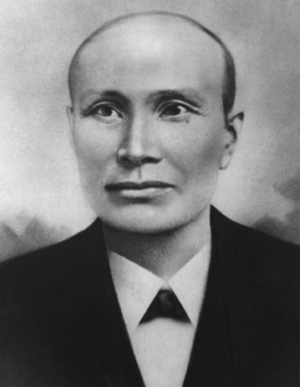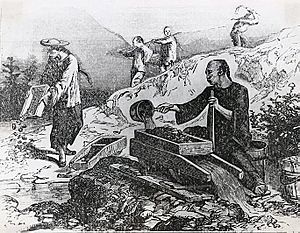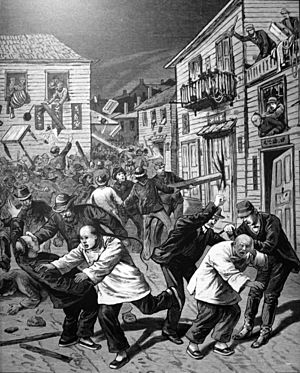Chin Lin Sou facts for kids
Chin Lin Sou (born September 29, 1836 – died August 10, 1894) was a very important leader in the Chinese American community. He was also a well-known person in Colorado. He came to the United States from Guangzhou, China, in 1859. Chin was different from many other Chinese immigrants at the time. He dressed in Western clothes and spoke perfect English. He was a supervisor for hundreds of Chinese workers. These workers helped build the transcontinental railroad and other train lines across California, Utah, Nevada, Wyoming, and Colorado.
Chin Lin Sou was one of the first Chinese immigrants in Colorado. He became rich by buying old mines and either selling them or working them himself. He was also a merchant, selling goods in Gilpin County and Denver, Colorado. People knew him as a leader. He started and joined groups that helped Chinese business people and communities. In 1977, a special stained glass picture of Chin was placed in the Old Supreme Court. This is inside the Colorado State Capitol building in Denver. It honors his important role in Colorado's history.
Contents
Early Life and Journey
Chin Lin Sou was born in Canton (which is now called Guangzhou) in southern China. This was on September 29, 1836. He left China in 1859 to get away from a civil war there. He traveled by sea to San Francisco, California. He had heard exciting stories about success in the American West. When he arrived, he spent several years mining for gold in California.
In the United States, people saw him as less "foreign" than other Chinese people. This was because he wore Western clothes. He was also over six feet tall, had blue eyes, and spoke English very well. Because of his eye color and height, his family might have come from northern China. People recognized him as a smart and quick learner. He was also very good at managing large projects.
Chin Lin Sou's Career
Building Railroads
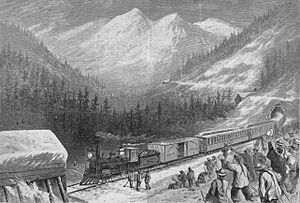
Chin Lin Sou worked on the first transcontinental railroad. He was a foreman, which means he led a group of Chinese railroad workers. Chin himself helped many of these workers come to the United States. He first worked for Charles Crocker of the Central Pacific Railroad. This was at Donner Pass in the Sierra Nevada Mountains of California. Later, he worked in the Great Basin of Utah. He worked alongside hundreds of Chinese people who had also left China's civil war. The transcontinental railroad was finished on May 10, 1869. This happened at Promontory, Utah. It was considered one of the greatest achievements of the 1800s.
He also worked in Nevada for the Central Pacific Railroad. Then, he worked for General Grenville M. Dodge of the Union Pacific Railroad. This company had joined with Central Pacific. Chin worked to make sure the train tracks met government rules. He worked in Utah, Wyoming, and Nebraska. This stretched from the Rocky Mountains to the Great Plains. In Colorado, he worked for the Denver Pacific Railroad. This company built a connecting line from Denver to the Union Pacific line at Cheyenne, Wyoming. Once Denver was connected to the transcontinental railroad, it could trade with markets across the country. This helped Denver become known as the "Queen City of the West."
Chin's leadership was very important for building the railroad. Railroad companies hired Chinese workers because they could pay them less than white workers. White workers also had shorter days and received food. Sadly, hundreds of Chinese workers died from sickness or injuries on the job. This was due to using explosives, mudslides, and avalanches. Their work included blasting mountainsides. After that, they cleared the rocks and built strong walls. At that time, there were no laws to protect railroad workers from dangerous jobs.
Mining for Gold
Chin Lin Sou was one of the first Chinese pioneers in Colorado. In 1871, he moved to Black Hawk, Colorado. There, he became the unofficial leader of a group of Chinese immigrants. They settled in a community called Cottonwood. This might have been the very first Chinese settlement in Colorado.
He earned good money as a mine supervisor. By 1874, he managed more than 300 Chinese workers. His team grew to include areas like North Clear Creek and Lower Russell Gulch. He managed the Chinese workers, including hiring them. He also negotiated their pay and wrote up work agreements with mine owners. Chin was also a merchant, selling them the supplies they needed. Chinese workers usually worked 10 hours a day. On Sundays, they worked 6 to 8 hours.
Chin became wealthy by buying and selling mines that others had left. Chinese miners could not claim new mines in the western United States. So, Chin started working mines that white miners had given up on. The Chinese were good at placer mining. This method used water to collect gold from stream beds. It was less profitable because it took a lot of time to find small bits of gold. Chin supervised hundreds of Chinese placer mines between 1870 and 1894, when he passed away. He and his mining partner, Edward L. Thayer, managed mines near Denver, Fairplay, Central City, and Black Hawk. They also ran supply stores in Gilpin County, Colorado. Chin became rich from selling two of his successful mines. His first deposit at the National Bank in Central City was for a large amount of money.
Chin had a good reputation in the community. People respected his polite and dignified behavior. They also admired his great skill in handling business. He was given a special seat of honor at the Central City Opera House. Chin was even offered the job of Central City marshal. But he turned it down because of unfair treatment against Chinese people. He said that "being Chinese gave him enough problems."
In 1874, a fire was blamed on the Chinese. There was a rumor that it started during their religious ceremonies. Chin told the Central City Register newspaper that "Chinese are too frequently made the victims of circumstance which any other nationality would escape without censure." He wanted their side of the story to be told. He said the fire started from a chimney that was not cleaned well or from a faulty pipe.
Life in Denver
Chin Lin Sou later moved to Denver. Chinatown had been started there by 1880. It was located between 14th and 17th Streets on Wazee. Chin continued to manage his mining work while also running a business in Denver. He brought goods from China, like furniture, food, and clothes, and sold them in Denver. He was a leader in the city and was known as the "Mayor of Chinatown."
He and other Chinese people faced unfair treatment and violence. The United States government passed a law that stopped Chinese immigrants from becoming citizens. This meant they could not go to court if they faced violence or discrimination. Chin helped start "The Six Companies." This was a group of Chinese American business and insurance companies. He was also a member of the Chee Kong Tongs. This was a group of Chinese people who came together to offer support, help, and loans to each other.
On October 31, 1880, a group of white people started a riot against the Chinese. One man, Sing Lee, was killed. Anyone who looked Chinese was attacked, and Chinese businesses were destroyed. Many Chinese people moved out of Denver to bigger cities, like Chicago. At its busiest, there were over 3,000 Chinese people living in Denver. The number of Chinese residents in Denver dropped from 980 in 1890 to only 110 by 1940. Later in the 1940s, there were only three Chinese families left.
Family Life
By 1873, Chin Lin Sou had earned enough money to bring his wife from China. They lived in Black Hawk, Fairplay, and Como. Later, they moved to Denver, living at 2031 Market Street.
He and his wife had six children. Their names included Lily, Chin Mon Lung, Chin Chin Lung, Edward, and Wawa. Over time, their children took on more Americanized names. Their last name often came after their first name. For example, Chin Mong Lung became Jimmy Lin Sou, and then Jimmie Chin. Similarly, Chin Chin Lung became Willie (also William) Lin Sou, and then Willie Chin.
Lily, their first child, was born in 1873. She is thought to be the first Chinese American child born in Colorado. She married Look Wing Yuen, a wealthy merchant. Willie became a successful businessman and was known as the mayor of Chinatown. Chin Lin Sou raised his children to live the American way of life. This included getting a public education. He wanted to stop a lottery that was common among the Chinese. This lottery often caused problems with the police. During World War II, Willie and Edward served in the United States Army Air Corps. When Willie died in 1939, Jimmy took over as mayor of Chinatown. Jimmy ran several Chinese restaurants. Even though many Chinese people had moved to different parts of Denver, he tried to keep a Chinatown community alive. This was especially important for older members of the community who had nowhere else to go. Wawa went to the Colorado Women's College and earned a business degree.
Chin Lin Sou became a citizen of the United States. He passed away on August 10, 1894. He was buried in Denver's Riverside Cemetery, which is the city's oldest cemetery. He is recognized as one of five important people buried there. Later, his family had his body moved and sent to China.
His Legacy
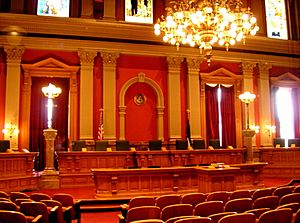
Chin Lin Sou, along with his children and later family members, became important people in Denver. A stained glass portrait of Chin was placed in the Colorado State Capitol in the old Supreme Court room in 1977. This was done by a special commission that celebrated Colorado's history. In the portrait, he is wearing a red Chinese gown. However, Chin usually wore business suits. He is also remembered with other pioneers on a mosaic tile wall at the Colorado Convention Center.
Images for kids


